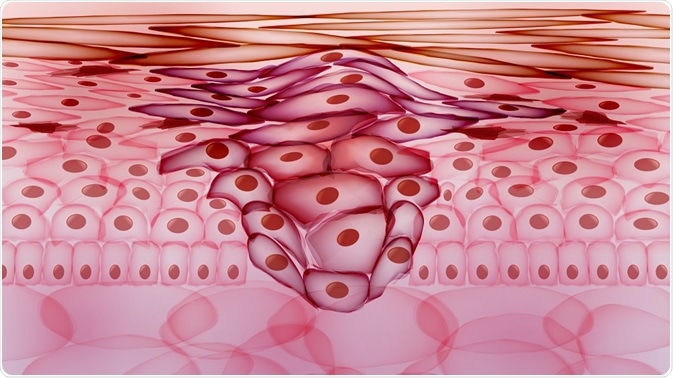Metastasis occurs when a tumour spreads from a primary site to a distinct secondary site within another organ. It typically involves several well-characterized steps.
 Metastasis Process" />
Metastasis Process" />
Credit: inbevel/Shutterstock.com
Cancerous cells initially enter the bloodstream or lymphatic system and are carried to other areas of the body via the circulatory system. After extravasating into surrounding tissues, such as bones, lymph nodes, lungs or liver, these cells can then grow to form a secondary tumor.
The stages of metastasis
After the cancerous cells have grown to form a primary tumor, matrix metalloproteinases (MMPs) are activated. These enzymes allow the cancer cells to invade local tissues by degrading basement membranes. These MMPS are either directly produced by the cancer cells or the extracellular matrix is stimulated by the cancer cells to produce them.
The invading cancer cells then undergo a process called epithelial to mesenchymal transition (EMT), in which the cells repress E-cadherins and upregulate N-cadherins. This process is due to the production of EMT-inducing transcription factors and allows cells to adopt a mesenchymal phenotype, aiding the ability of cells to intravasate into the blood stream. N-cadherins also have decreased intracellular adhesion in comparison to E-cadherins, permitting further local tissue invasion.
The cancerous cells can then enter the blood stream or lymphatic system in a process called intravasation, by squeezing through the surface of a blood vessels. Once within the circulatory system, they disseminate to distinct sites of the body and become lodged into the capillaries of other organs.
These cells then undergo extravasation by moving through the vessel membranes and forming micro-metastasizes. At this point, the cancerous cells can colonies, forming secondary tumors. These new tumors will then stimulate additional angiogenesis, triggered by hypoxia, forming a new blood supply to support further growth and metastasis.
Most cancerous cells will not survive this process, particularly due to the hydrodynamic stresses of migrating in the blood stream and the immune system. One protective mechanism utilized by migrating cancerous cells includes the formation of heterotypic clumps, in which they bind to platelets and evade the immune system.
It is the overall function of the various protective mechanisms to allow a small minority of around 1 in 10,000 cells to survive and form secondary tumors.
Location of metastasis
Whether a cancer metastasizes or not depends on numerous aspects. These include the type of cancer, treatments and the aggressiveness of the cancer.
Certain cancers also often metastasize to specific organs, for example, breast cancers commonly metastasize to the liver, brain, lungs and bones; and lung cancers commonly metastasize to the liver, bones, adrenal glands and brain. This difference is often determined by the architecture of circulation, with secondary tumors found at early organs located downstream from the primary tumor.
Lungs are the most common organ of secondary tumor formation as they are the first organ that blood enters after leaving most organs. Other factors are also involved, such as in prostate cancer, where cells often metastasize to the bone marrow due to genetic factors.
Detection and treatment of metastatic cancer
Before a cancer can be treated, it is important that the type and location of tumor(s) are identified. This allows the use of targeted and effective treatments. One possible method that is used to detect metastasis is the use of radiolabeled glucose.
Since cancer cells are constantly replicating, they require a large amount of glucose. Therefore, the radioactive glucose is taken up by the cancerous cells and can be detected on a CT/PET scan, identifying the location and quantity of tumors.
Most metastasized cancers currently have very limited treatment options. One possible method is by preventing angiogenesis, hence preventing the growth of new tumors and spreading of cancerous cells through the blood stream. Other methods include inhibition of MMPs and VEGF antibodies.
Further research into treatment is vitally important as over 90% of cancer related fatalities are due to metastasis. If a tumor stays in its primary site then it is often not fatal, unless it affects the function of that organ such as with brain tumors.
Metastasis is therefore a very important target in cancer therapy, as inhibition could dramatically reduce fatality rates.
Metastasis
Further Reading